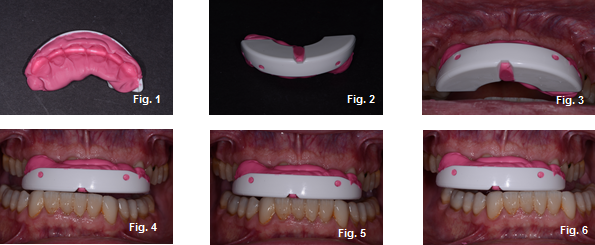Selecting the Best Temporary Occlusal Appliances
By Gary DeWood on October 8, 2015 |Occlusion can be a very dividing issue among dentists. Still, I don't think that any dentists would disagree that occlusion can be involved in joint issues, muscle issues, sleep issues, stress issues, postural issues, cervical issues, functional issues and more. How and to what degree occlusion is involved, and what should be done to address the occlusal component is where the differences become apparent and often emotional.
Recognizing that these differences of opinion exist, I know that anyone who deals with occlusion will have occasion to interfere with it. Not infrequently that interference is designed to judge the degree to which occlusion is involved in the patient’s symptoms. Temporary occlusal appliances can be excellent tools to quickly and inexpensively judge that involvement. Click here for more on the appliance as a diagnostic tool.
Anterior temporary appliances keep the back teeth out of contact when “biting” and in all movements, effectively shutting down the closing muscles for most patients.1 Posterior temporary appliances provide contact on the back teeth in all possible positions and movements, supporting the jaw joints and lowering the forces that can be applied across them. 2
Anterior Temporary Appliances
The simplest form of an anterior temporary appliance would be the temporary Lucia Jig we frequently use during an examination. These are available from many sources and can be easily made using acrylic or composite if the dentist chooses not to purchase them pre-formed. When more wear time of the appliance is desired, these jigs are usually not an appropriate choice since they are small enough to be easily swallowed or aspirated. This is obviously not an outcome in the best interest of the patient or the dentist.
Any anterior appliance that will be sent home must be large enough to resist swallowing and aspiration. I want one that is very easy to fabricate, insert and adjust. It would be beneficial if it could also provide me with some information about what a patient does with his or her teeth by creating wear on the appliance that we can read. A QuickSplint appliance nicely fulfills these requirements.
The QuickSplint is lined with bite registration material, the excess is trimmed away, and the patient can be sent home with instructions for wearing the appliance. The chairtime required is minimal, and the functional surface of the appliance is made of material that is designed to wear, illustrating for me the pattern of parafunction. (Figs. 1-6)

Posterior Temporary Appliances
A posterior-contact-only appliance can be life altering to wear when a patient is suffering from pain of an intra-articular origin. Because they “unload” the joints by minimizing the force passed through them when teeth contact, they are often the only way to get a patient with intra-articular pain more comfortable. When a pre-fabricated temporary posterior appliance is required, my selection is the Aqualizer. An Aqualizer is composed of two reservoirs filled with water that cover the occlusal surfaces of posterior teeth. The reservoirs are connected by a channel that “equalizes” the Aqualizer by moving water between the two reservoirs to produce equal pressure. Joints love the support that the Aqualizer provides. (Figs. 7-9)

Segmental appliances do increase the risk of tooth eruption or intrusion, but that's a topic for another discussion.3,4
Temporary occlusal appliances are necessary tools in any restorative practice. The QuickSplint and the Aqualizer are both excellent examples of tools every restorative dentist can have available when the need to temporarily interfere on an occlusion presents itself.
Gary DeWood, D.D.S., M.S., Spear Faculty and Contributing Author
References:
- Braz Oral Res. 2012 Nov-Dec;26(6):530-5. Epub 2012 Sep 27. The effect of a Lucia jig for 30 minutes on neuromuscular re-programming, in normal subjects. Nassar MS1, Palinkas M, Regalo SC, Sousa LG, Siéssere S, Semprini M, Bataglion C.
- Cranio Clin Int. 1991;1(2):81-98. Review. Gelb appliance: mandibular orthopedic repositioning therapy. Gelb ML, Gelb H.
- Br Dent J. 2011 Feb 12;210(3):109-10. doi: 10.1038/sj.bdj.2011.46. Dental appliances with inadequate occlusal coverage: a case report. Chate RA1, Falconer DT.
- 4. J Am Dent Assoc. 1984 Mar;108(3):359-64. A critical evaluation of orthopedic interocclusal appliance therapy: design, theory, and overall effectiveness. Clark GT.
Spear Resources
Occlusal Appliances
Download our e-book that includes articles and visuals from Dr. Frank Spear for easy-to-follow strategies to understand Occlusal appliances.
Download Now